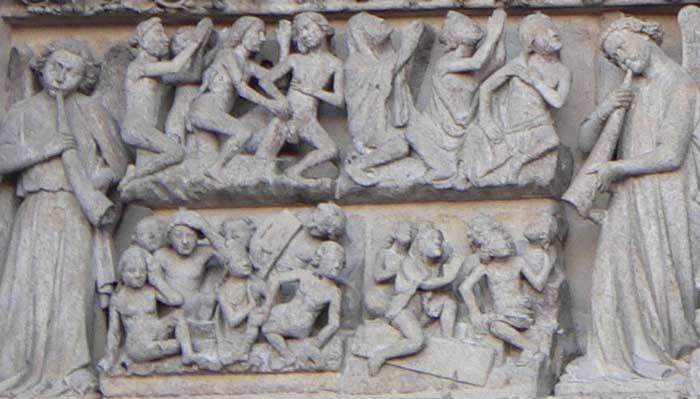jmd
Before posting our two main compare cards, I thought I would show one of the ever so common petroglyph carving in nearly every major town in France that has a major Church or Cathedral from the 12th through to the 14th century (overlapping late Romanesque to late Lumiere or 'Gothic' styles):
 These are quite common, and usually form the third horizontal series below a row of souls headed in two alternate directions, themselves below Christ.
These are quite common, and usually form the third horizontal series below a row of souls headed in two alternate directions, themselves below Christ.
This raising of the dead from tombs is in all cases I have seen (quite a few) accompanied by at least one (often more) angel blasting a 'trumpet' (or cornet). The image, then, is quite common, but always below a Christ figure. Usually, within this same overall depiction is also an (arch-)angel holding scales tipping in favour of a symbolic Christ (lamb on one side, for example), and depictions of devils and angels.
But on to the cards:
 <-- Dodal | Conver -->
<-- Dodal | Conver -->

Another example of the Conver card (the one owned by Kenji) can be seen on the ATS site.
One item that is striking (perhaps only for me as an ex-clarinet player) is that in all these cases the right-hand is nearer the mouth, with the left hand supporting the 'bulk' of the weight of the instrument.
Also, though the two cards show the cornets as 'straight', in most instances I have seen they are curved as depicted on the petroglyph above. Seen front-on, however (as on the cards), they would appear straight. I would suggest that perhaps these are still intended or seen by people of earlier times as having a curve towards the viewer.
Both cards have three human figures, and it seems relatively clear that the left-hand depiction is of a woman, and the right-hand one of a man. The central one is often claimed to be of a child, yet personally find this incongruous with the relative size depicted and, importantly, the 'fontanelle' bald area, more reminiscent of a monk than of a child.
The central figure is also quite peculiar, and both the Dodal and Conver depict a clear difference between his or her (or 'its' if considered androgenous) left and right sides.
Of the 'grave' itself, the Dodal is very much lacking in detail, and would be hard pressed to recognise it as such were it not for other depictions that 'educate' our senses to the intended image.
The Dodal also includes 'droplets' or 'yods' - though personally suspect that these are more, in this case, an artistic 'filler' than of major symbolic significance.
The appearance of the angel, in each case, via an apparture opening into the world is both something that is quite distinct and different to the stone carving above, and also calls to mind, in an inverse sense, the later and now quite famous Flammarion woodcut.

This raising of the dead from tombs is in all cases I have seen (quite a few) accompanied by at least one (often more) angel blasting a 'trumpet' (or cornet). The image, then, is quite common, but always below a Christ figure. Usually, within this same overall depiction is also an (arch-)angel holding scales tipping in favour of a symbolic Christ (lamb on one side, for example), and depictions of devils and angels.
But on to the cards:


Another example of the Conver card (the one owned by Kenji) can be seen on the ATS site.
One item that is striking (perhaps only for me as an ex-clarinet player) is that in all these cases the right-hand is nearer the mouth, with the left hand supporting the 'bulk' of the weight of the instrument.
Also, though the two cards show the cornets as 'straight', in most instances I have seen they are curved as depicted on the petroglyph above. Seen front-on, however (as on the cards), they would appear straight. I would suggest that perhaps these are still intended or seen by people of earlier times as having a curve towards the viewer.
Both cards have three human figures, and it seems relatively clear that the left-hand depiction is of a woman, and the right-hand one of a man. The central one is often claimed to be of a child, yet personally find this incongruous with the relative size depicted and, importantly, the 'fontanelle' bald area, more reminiscent of a monk than of a child.
The central figure is also quite peculiar, and both the Dodal and Conver depict a clear difference between his or her (or 'its' if considered androgenous) left and right sides.
Of the 'grave' itself, the Dodal is very much lacking in detail, and would be hard pressed to recognise it as such were it not for other depictions that 'educate' our senses to the intended image.
The Dodal also includes 'droplets' or 'yods' - though personally suspect that these are more, in this case, an artistic 'filler' than of major symbolic significance.
The appearance of the angel, in each case, via an apparture opening into the world is both something that is quite distinct and different to the stone carving above, and also calls to mind, in an inverse sense, the later and now quite famous Flammarion woodcut.

